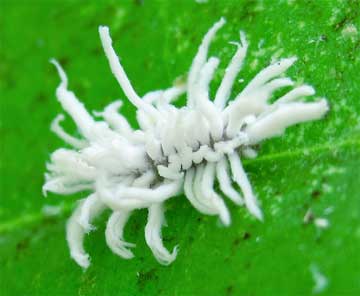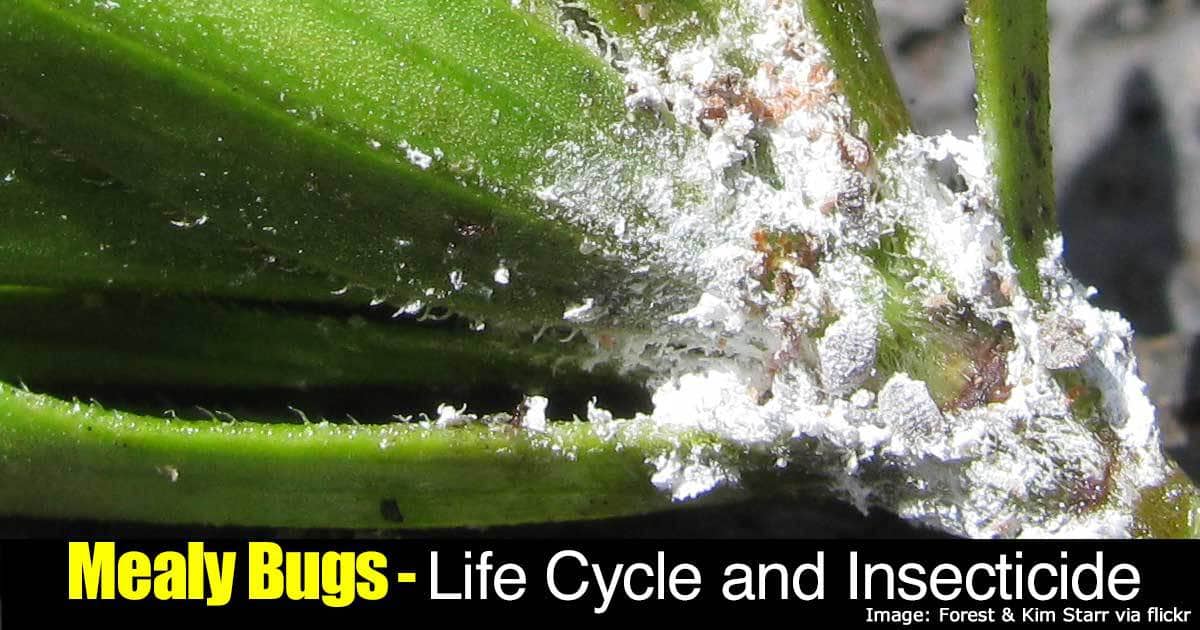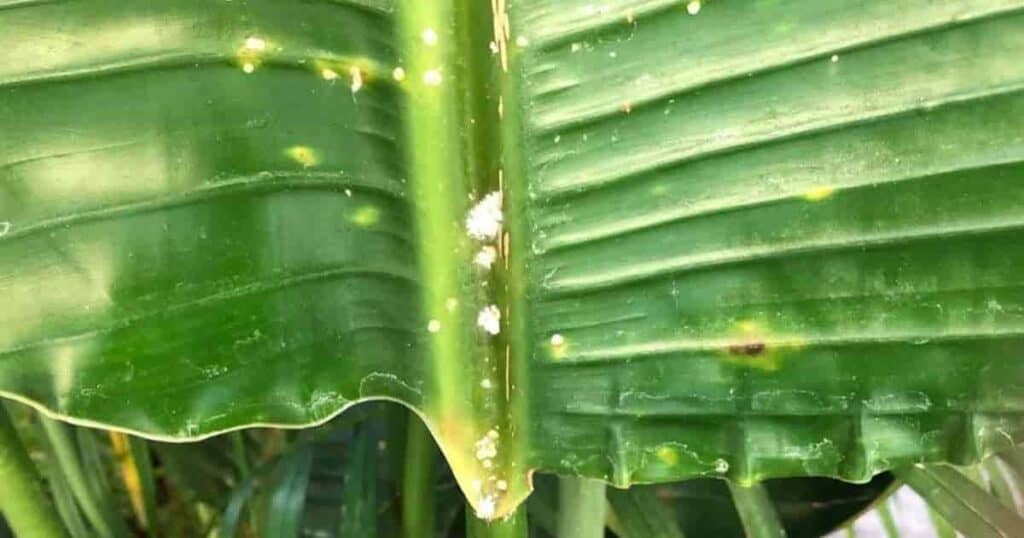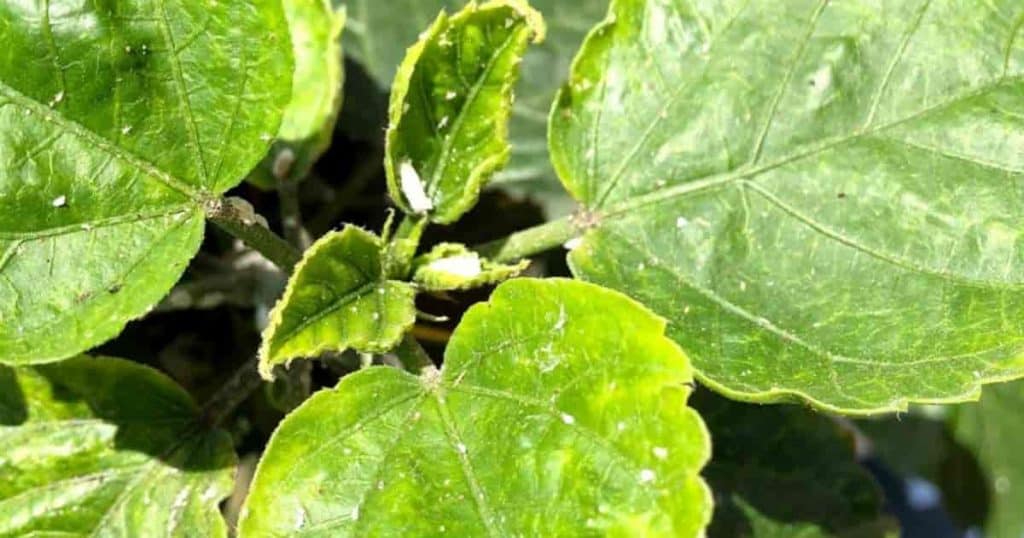Most people want to know – How To Get Rid of Mealybugs?
They usually ask the question after seeing mealybugs on their indoor plants or other ornamental plants in the landscape.

If you have noticed that mealybugs look like small pieces of cotton or blotches of powder all over the leaves, those small, fuzzy, tiny white bugs on plants are probably mealybugs.
If you’ve seen them, naturally, mealybug control will be a priority.
- What Do Mealybugs Look Like And Why Is Mealy Bug Control Necessary?
- Watch For Ants Feeding On Mealybug Honeydew
- Mealybugs On Houseplants – What Plants Get Them On The Most?
- How To Get Rid Of Mealybugs – A Problem On Plants
- Mealybug Treatment On Orchids?
- 8-Step Process For Orchid Mealybug Control And Eradication
- How to Get Rid Of Mealybugs On Succulents?
- All Natural Mealy Bug Control With Beneficial Insects
What Do Mealybugs Look Like And Why Is Mealy Bug Control Necessary?
Mealybugs are white, soft-bodied, cottony-looking insects with a protective waxy coating and equipped with piercing/sucking mouth parts under order Hemiptera.
They are like plant scale bugs and aphids in that they suck the fluids from green leaves and stems, robbing plants of essential nutrients and plant vigor of their host plants.
Mealybugs excrete large amounts of honeydew. This makes an excellent “growing soil” for a black fungus called sooty mold. Some of the known species of mealybugs that are likely to infest your home and garden include:
- Pink hibiscus mealybug (Maconellicoccus hirsutus)
- Vine mealybug
- Citrus mealybug (Planococcus citri)
- Grape mealybug
- Long-tailed mealybug (Pseudococcus longispinus)
- Pineapple mealybug
- Obscure mealybug (Pseudococcus viburni)
Sooty mold is unattractive and interferes with photosynthesis, and it can also retard the growth of the plant.
This can also make the leaves and floors sticky. Sooty black mold usually whithers away after removing the mealybug.
Watch For Ants Feeding On Mealybug Honeydew

Mealy bug has a life cycle of about 30 days. Where do mealybugs come from?
Ants feed on the honeydew when you find ants crawling around your plants indoors or out or observed making a nice trail from a plant.
Take some time to examine your houseplants closely for these sucking pests.
These annoying white bugs on plants do well indoors – they love and live very well in warm, dry environments. These houseplant pests have a life cycle of about 30 days.
These crawlers normally call home, and adult female mealybugs deposit their eggs in cottony egg sacs where leaves join stems, branch crotches, nooks, crannies, or along leaf veins.
When the eggs hatch, their feeding on soft growth will cause leaves to turn yellow and leaf drops to occur.
Damaged plants look withered and may have sticky sap on the leaves or stems.
Mealybugs On Houseplants – What Plants Get Them On The Most?
Some of the houseplants most commonly affected by mealybugs include:
- The African violets pests include root and foliar African Violet mealybug
- Aglaonema
- Read our articles on cactus mealybugs and succulent mealybugs
- Dracaena plants
- Ferns
- Hoya
- Palms
- Ficus – weeping fig
- Pothos plants – Green Jade, Golden & Marble Queen
- Philodendron
- Norfolk Island Pine – Araucaria Plant
- Schefflera
- Jade succulent with yellow leaves falling off
- Yucca trees
- Spineless Yucca Elephantipes

Aside from houseplants, mealybugs frequently attack fruit trees like citrus, grapes, pomegranate, and pears.
Woody ornamental plants and herbaceous perennials are also prone to these pests. They include:
- Coral bells
- Figs (Ficus)
- Flax grasses (Phormium)
- Fuchsia
- Gardenia
- Hibiscus
- Jasmine
- Mimosa
- Miscanthus grasses
- Oleander
How To Get Rid Of Mealybugs – A Problem On Plants
Here’s how to kill mealy bugs.
As with soft-scale insects, an easy control method is to apply alcohol with cotton swabs directly on the mealybug.
Wiping down the foliage regularly and helping keep plants clean will help keep these white fuzzy bugs in check.
Related: Read Using Neem Oil To Clean Plant Leaves
For an insecticide, we use neem oil on mealybugs. If a plant becomes severely infested, consider using Neem, a safe, organic natural insecticide for plants to control the pest, or make your own homemade insecticidal soap or possibly horticultural oils.
Neem oil can be found at your local garden center. Always read the pesticide label and wear appropriate safety equipment when applying any chemical.
For heavy infestations of mealybugs that are hard to reach, try spraying directly on the insects with a mixture of 10% rubbing alcohol and 90% percent water. Repeat applications weekly until the bugs are gone.
Always test any insecticide, soap spray, or alcohol mixtures on a small portion of the plant before full application, as some plants may be sensitive to dish soap or alcohol. Systemic insecticides are another possibility, although I try to avoid them.
Mealybug Treatment On Orchids?
Here’s how to get rid of mealy bugs.

Prevention is the best way to get rid of mealybugs on orchids. These pests can come from a number of sources, such as:
- Plants that have been allowed to spend time outside during the warm months
- Fresh produce or flowers (either purchased or brought in from outdoors)
- Put in place by ants seeking to set up a “farm” to harvest honeydew
- New plants introduced to your collection
- Use of contaminated potting medium
Whenever you purchase a new plant, bring plants or produce in from outdoors, inspect thoroughly for mealybugs and ants!
Quarantine new plants for a couple of weeks to avoid introducing pests to your orchids and other houseplants.
Related: How To Get Rid Of Mealybugs on Fiddle Leaf Fig
Kill The Mealybugs When You See Them
Luckily, mealybugs are susceptible to many non-toxic home remedies, so you do not need to use toxic pesticides in your home to eliminate a mealybug infestation of your orchids.
One of the simplest and most popular mealybug treatments is simply to use a cotton swab dipped in alcohol on these pests when you see them. Killing mealybugs with alcohol kills them on contact.

Don’t just treat the obvious ones, though. Instead, inspect the entire orchid to find any lurking in the leaf joints, under leaves, substrate, or in crevices in the container.
To eliminate mealybugs, check frequently and treat them repeatedly to be certain of killing them all.
Mealybugs Control On Orchids With Homemade Insecticidal Soaps
Make an effective mealybug treatment (insecticide soap) using a mild spray mix of a liter of distilled water and a teaspoonful of organic liquid castile soap. Doctor Bronner’s makes a good product.
Related: Check Out our Homemade Recipe For Insecticidal Soap
You can also make a liter of orchid-safe mealy bug spray by combining distilled water and isopropyl alcohol 50/50 along with a teaspoonful of liquid castile soap in a spray bottle.
Spraying alcohol will help kill off mealybug eggs.
Spray on the plant (orchids) lightly early in the day. Be sure they are in an area with bright, indirect light and good air circulation so the water and spray will dry thoroughly.
You don’t want your orchid leaves to stay damp for an extended period of time.
Heavily infected orchids can be rinsed in a castile or dish soap and water solution, rinsed, and dried thoroughly.
It is not a good idea to spray or rinse blossoms or buds. If mealybugs infest an orchid in bloom, it’s best to sacrifice the blossoms by pruning them to save the plant.
Neither alcohol nor mild insecticide soaps have residual effects, so you will need to treat them repeatedly over several days to eradicate all the pests.
Check back daily to be sure the job is complete.
Mealybug Spray: Neem Oil Has A Residual Effect
A mild solution of organic neem oil is also safe to use on orchids.
Neem oil is a natural pest control product and is very versatile. You will surely find many uses for Neem oil on all your house plants and in your garden.
Be sure to follow packaging directions carefully when using the concentrate to make foliar sprays and soil drench solutions.
Despite its residual effects, neem oil should be applied several times for the best results.
8-Step Process For Orchid Mealybug Control And Eradication

Follow these eight steps to get rid of mealybugs and keep them away:
#1 – Be vigilant! Examine all plants and their containers thoroughly for mealybugs regularly.
#2 – Inspect all of your plants and treat them as needed.
#3 – When you see mealybugs, act immediately.
- Wash heavily infested orchids with a mild insecticidal soap solution or neem oil.
- Use a cotton swab with alcohol to treat mild infestations.
- Change container and substrate if necessary.
- Prune blossoms if necessary.
#4 – Wash down your plant area using a strong soapy water solution. Finish up by spraying the area with alcohol and wiping it down again.
You can add a little neem oil to the alcohol spray for added residual effect.
#5 – Quarantine affected plants – ensure they are not touching other plants and treat them with neem oil spray.
#6 – Carefully observe the affected orchid. Check it daily and use a cotton swab dipped in alcohol to kill off any mealybugs that may reappear.
#7 – If you still see mealybugs after a week, treat them with neem oil spray again.
#8 – Keep the orchid in quarantine for several weeks. You can put it back in your collection when you no longer see any sign of mealybugs.
Keep A Clean Plant Area
Mealybugs can hide in crevices and remain alive in a dormant state even when plants are not present.
Move your plant collection and wipe down all surfaces with soap, water, and alcohol regularly.
Check and wipe down the bottoms of containers, saucers, and all equipment used to care for your orchids and other houseplants.
Mealybugs can hide out in medium and regular orchid potting soil.
If they are a recurring problem, you may need to repot orchids and other plants with fresh, new substrates.
When you repot orchids, clean and treat the roots with a mild insect soap mix and rinse thoroughly before placing the plant in its new substrate. [source]
How to Get Rid Of Mealybugs On Succulents?
Mealybugs are susceptible to all sorts of pesticides and homemade pest control solutions, but one of the simplest and most affordable for use with succulents is 70% alcohol.
These pests can be killed on contact with a little rubbing alcohol on a cotton ball, or you can simply spray your succulents with straight alcohol to kill off both the pests and their eggs.
In cases of heavy infestation, you can even use straight alcohol as a soil drench to kill the bugs and their eggs in the soil surrounding the plant.
For more details, read our article: Mealybugs on Succulents.
Quarantine Affected Plants
When you see a mealybug infestation on one of your succulents, remove or separate it from your collection. It is helpful to give plants a good drenching and keep them apart for a few weeks.

Check every day and treat for mealybugs as needed by spraying. Check all parts of the plant and its pot for any bugs hiding in crevices.
Take special care to inspect the base of the stem, as these bugs hide in the soil surrounding the plant. Spray or drench this area liberally.
It’s also a good idea to clean up your infested plant area with a strong detergent and water solution and treat other members of your succulent collection with rubbing alcohol.
It won’t hurt them and may help prevent a major infestation. Many enthusiasts simply keep a spray bottle of rubbing alcohol close at hand for regular treatments.
Related: What Are The Fuzzy White Bugs On Plants?
Is Straight Rubbing Alcohol Really Safe For Succulents?
For succulents, regular use of rubbing alcohol does not seem to be harmful. It kills the pests on contact and then evaporates quickly, so it doesn’t have a chance to damage plants or roots.
Most succulent enthusiasts agree that alcohol is the most affordable and simplest solution for getting rid of mealy bugs on succulents.
However, if you don’t want to use alcohol or don’t have it on hand, add a teaspoonful of dish soap to a quart of water to make a spray.
If you have a succulent outdoor garden, keep a healthy population of natural predators, such as Lady Bugs.
Vigilance Is Key To Defeat and Kill Mealybugs
If you can catch mealybugs before they have a chance to reproduce much, you should be able to control mealybugs or even eradicate them with the rubbing alcohol method.

Just be sure to treat infestations repeatedly until you see no more mealybugs. Then, continue to spray and perform preventative measures on a regular basis.
All Natural Mealy Bug Control With Beneficial Insects
Another option is to use beneficial insects or natural enemies for biological or natural control of mealybugs.
For example, one mealy bug killer is the beneficial insect, also known as the “Mealybug Destroyer” or Cryptolaemus montrouzieri technically and as “Crypts” for short.
They, like the excellent garden friend the ladybug, Cryptolaemus montrouzieri are lady beetles. But, unlike ladybugs, these beneficial insects hang around after release and do not disappear.
Leptomastix dactylopii makes another natural enemy of mealybugs. They are parasitic wasps that attack citrus mealybugs.
You can also go for other mealybug destroyers after nymphs, aphids, spider mites, fungus gnats, and more.
Moreover, other naturally occurring predators include brown lacewings, minute pirate bugs, and spiders.
Recommended Reading
Image: Forest and Kim Starr | puuikibeach